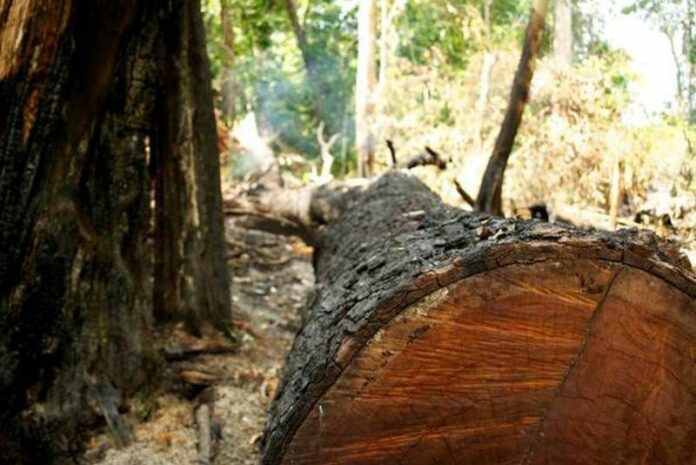
KOH KONG, CAMBODIA (DPA) — The narrow, twisting path up Cambodia's Crocodile Mountain was made for illegal logging, but is now more used by tourists visiting the fragile habitat, often guided by the former loggers themselves.
Their expert local knowledge gleaned from years of scouring the forest for valuable hardwood trees is being put to better use thanks to the efforts of hiking group Sustainable Adventures in Cambodia.
Led by local Buddhist abbot Dhammajat and Belgian expatriate Jonas de Schrijver, the group has organised 10 hikes over the past two years.
It recruits guides like Mom Ki, from nearby Kampong Speu province, to lead hikers up Crocodile Mountain and through the vast and relatively unexplored Cardamom mountain chain in the south-west of the country.
At 46, Mom Ki is one of the younger of the five guides.
On a recent hike in May, he helped to guide 16 foreigners and two Cambodian hikers up the mountain, carrying supplies on his back in a converted rice sack.
Mom Ki was paid 90 dollars for the three-day trip, compared with the 128 dollars monthly minimum wage in a factory.
But the benefits are more than just financial for him.
"For me, who loves nature, I feel happy to see foreigners come to visit the forest," he said.
Like many locals, Mom Ki has an ambivalent relationship with the forest. He is half Chong, an ethnic animist group, and used to believe the forest that he helped to cut down also contained spirits.
The diverse ecosystem has also impressed international conservationists.
The Cardamom Mountains, which stretch from south-western, coastal Cambodia up into Thailand, are "one of the most species-rich and intact natural habitats in the region," according to the World Wildlife Fund, and one of most pristine in Asia.
Private logging was effectively outlawed during the 2000s, but the activity persists, either by well-connected individuals who obtain the right permits, forest clearance in the name of sometimes bogus construction projects, or small-scale timber poaching for hardwood or charcoal.
The country has lost 2,850 million hectares of forest over the past 20 years, one of the highest rates in the world, according to the UN Programme on Reducing Emissions from Deforestation and Forest Degradation.
Ecotourism would preserve the trees and improve the community's overall welfare, de Schrijver said.
"If [guides] can make 30 dollars a day and work 20 days a month, that's 600 dollars. For a person in a village, essentially they are rich," said de Schrijver, who hopes to one day turn the hiking venture, currently an informal project, into a full business.
The model has worked for Chi Phat community ecotourism centre in the nearby Areng Valley, which takes 3,000 tourists on guided hikes each year, project manager Martin Leighfield says.
The centre began as an initiative of the US-Cambodian Wildlife Alliance and now employs 250 locals, including ex-loggers.
But such projects face several challenges, some cultural, de Schrijver said. For example, guides need to learn to adjust the Cambodian sense of time to the more punctual expectations of foreigners, especially those on a travel schedule, he said.
On a more institutional level, the move away from logging has wide-reaching impacts, with rosewood or teak lumber selling on for 2,000 to 5,000 dollars per cubic metre, for example on forum Alibaba.
Despite the ban, the industry is deeply linked to the political and social landscape, according to Australian National University researcher Sarah Milne, who has worked in the Cardamom Mountains for the past decade.
The industry has generated billions of dollars, some of which finds its way into the local government and economy, she said.
"A portion goes back into provision of public goods and donations, like gifts of temples, office buildings and roads," she said.
"In a lot of communes, this off-budget finance turns out to be bigger than the formal government budget."
Turning loggers into guides is just the first step, she said. The next would be to figure out how to compensate for the lost revenues.
Loggers make between 150 and 300 dollars for each hardwood tree, which can take several weeks to find, cut down, and then bring down the mountain in pieces on their motorbikes.
Others cut down less valuable trees to burn into charcoal, while villagers are also employed to scout trees on behalf of loggers.
But the real beneficiaries are Cambodia's politically connected elites, Milne said.
In the Cardamom Mountains alone, logging generated half a billion dollars between 2009-12 for just "one tycoon and relatives of the prime minister," according to a book she co-authored on the subject.
"There's a lot at stake, and it will be hard to deal with the vested interests," Milne said. "But when all that wildness goes, you'll have really lost something."
(Reporting by Erin Hale)
You can also find Khaosod English on Twitter and Facebook
http://twitter.com/KhaosodEnglish
http://www.facebook.com/KhaosodEnglish










































